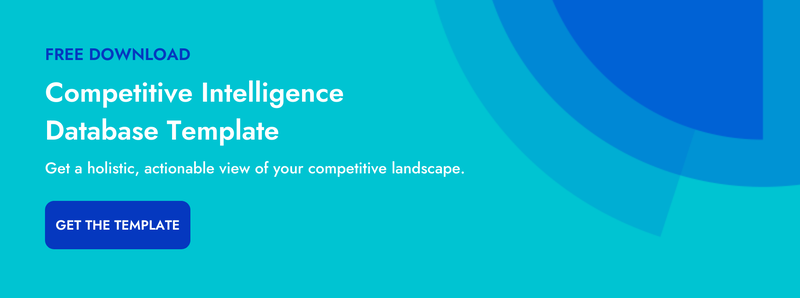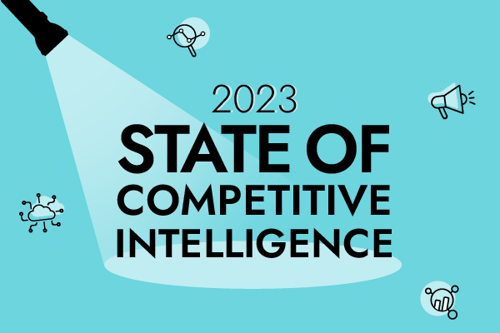Do you find yourself meaninglessly scrolling through the internet looking for intel on your competitors? Well, you can make that time 10x more effective with just a few tips and tricks. It’s all a matter of setting goals, looking at the right sources, and using your intel to enable your sales, marketing, and product teams. Check out these five ways you might be wasting time on competitive intelligence research.
1. You’re Not Setting Goals and KPIs
It’s too easy to get lost in the world of internet research. One minute you’re reading a competitor’s press release, and three hours later you’re reading about how their CMO has 20 endorsements for “creativity” on LinkedIn. Instead of wasting time browsing site after site, you should be setting goals and KPIs to frame your research. The most successful companies use a mix of qualitative and quantitative metrics to analyze the impact of market and competitive intelligence. KPIs should help influence the way your company uses intel to align with internal goals and priorities. Set goals, ask questions, and search with intent! Use your time to be as efficient as possible.
 2. You’re Not Tracking Enough Sources
2. You’re Not Tracking Enough Sources
There are millions of different data sources for competitive intelligence. These sources can range from Quora threads, to Glassdoor employee reviews, to Instagram posts. By widening the scope of data sources, you can more easily recognize and track trends, both within a company and within the entire industry. A Quora thread can surface a product limitation shared by a customer, an employee review can reveal issues in customer service delivery, and an Instagram post can uncover the company’s growth trajectory. These often-ignored sources of intelligence can surface a wealth of data and insights. Tracking a competitor’s complete digital footprint is critical to capture every move and identify trends.
3. Your Sources Aren’t Creating Enough Value
You’re tracking your competitors’ Facebook, Twitter, Instagram, and you have them on Google Alerts, but now what? While social media accounts and Google Alerts may be helpful for tracking large-scale company news, this forces you to be reactive to company updates. However, if you were tracking Glassdoor employee reviews along with G2 Crowd product reviews, you wouldn’t have been surprised about the massive turnover on the engineering team and coincidental product outage that occurred last month. If you’d been tracking sources that provided you with valuable insights, you could have prepared a marketing campaign to highlight the reliability of your software and services in response to what you discovered about your competitor.
Another way to improve the scope of your sources is to track indirect and aspirational competitors. If you find yourself exclusively tracking direct competitors, you might risk getting blindsided by industry shifts. The aftermath of Amazon’s acquisition of Ring reveals how important it is to keep tabs on companies beyond your direct competitor focus. While individual pieces of intel may not be urgent and actionable, overall trends and patterns can help you prepare more for a large and impactful change.
4. You’re Not Consistently Sharing Intel
Once you’ve gathered all of your intel and trends about competitors, you can’t just hibernate and wait to share your findings in the spring! Instead, it’s important to equip your sales, marketing, and product team with updates about the competitive landscape in real-time. Outdated information is harder to act on, so live competitive intelligence should be a priority for your teams. Tools like battlecards and competitive alerts can help your sales and product team stay aligned, and ensure that your team is never caught off guard. Instead, your sales team will know exactly how to combat tricky questions about competitors, and the product team can adjust priorities to stay ahead.
5. You’re Not Acting On Your Intel
Now that your teams are equipped with market intel, you need to create value for your company by acting on your competitive findings. For example, let’s say that your intel shows that target customers want a 1:1 relationship with a customer service representative, but don’t want to pay enormous fees. Your competitor used to offer this 1:1 relationship for free, but now charges a monthly fee for this service. However, your company provides a 1:1 relationship for free, with no intention of increasing price. This information could drive your decision to adjust your marketing efforts to emphasize your free customer service, compared to competitors. Additionally, you could create more case studies about customers who utilize your customer service team to improve their business operations.
Marketing campaigns such as these are great ways to turn your intel into action and drive impact for your business. Sales enablement content such as battlecards are a great ways to turn intel into impact through your sales team’s success. Every team - from marketing to sales to product and beyond - in an organization can benefit from competitive intelligence insights, so be sure that you’re being proactive in your approach to intelligence, tackling competitive changes head-on and staking your claim as the leader in your industry.
Related Blog Posts
Popular Posts
-
 How to Create a Competitive Matrix (Step-by-Step Guide With Examples + Free Templates)
How to Create a Competitive Matrix (Step-by-Step Guide With Examples + Free Templates)
-
 The 8 Free Market Research Tools and Resources You Need to Know
The 8 Free Market Research Tools and Resources You Need to Know
-
 Sales Battlecards 101: How to Help Your Sellers Leave the Competition In the Dust
Sales Battlecards 101: How to Help Your Sellers Leave the Competition In the Dust
-
 6 Competitive Advantage Examples From the Real World
6 Competitive Advantage Examples From the Real World
-
 How to Measure Product Launch Success: 12 KPIs You Should Be Tracking
How to Measure Product Launch Success: 12 KPIs You Should Be Tracking




